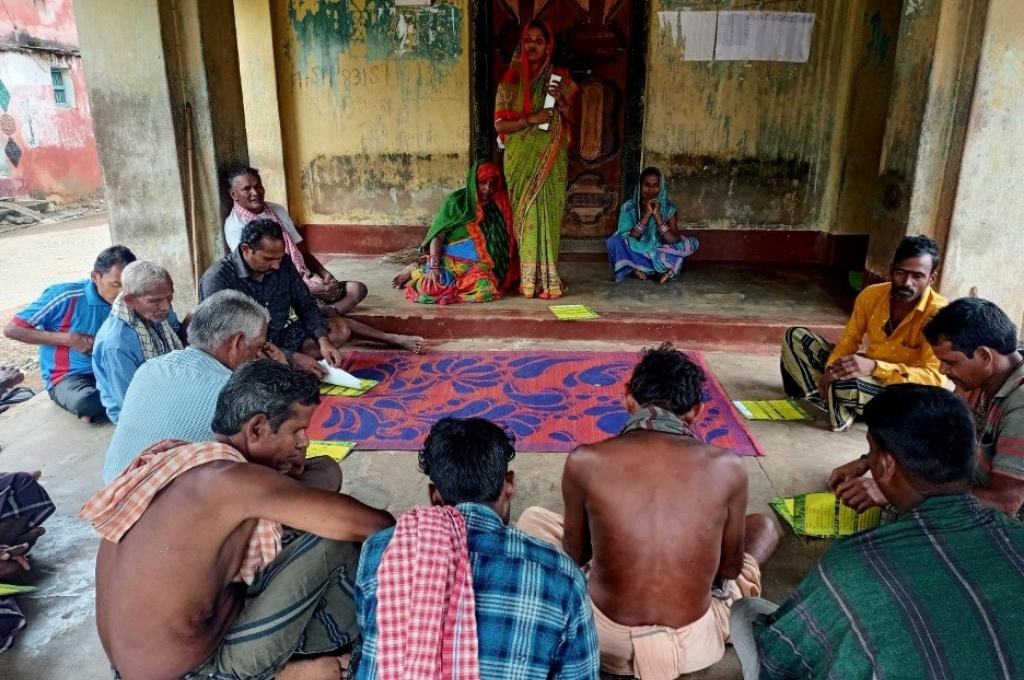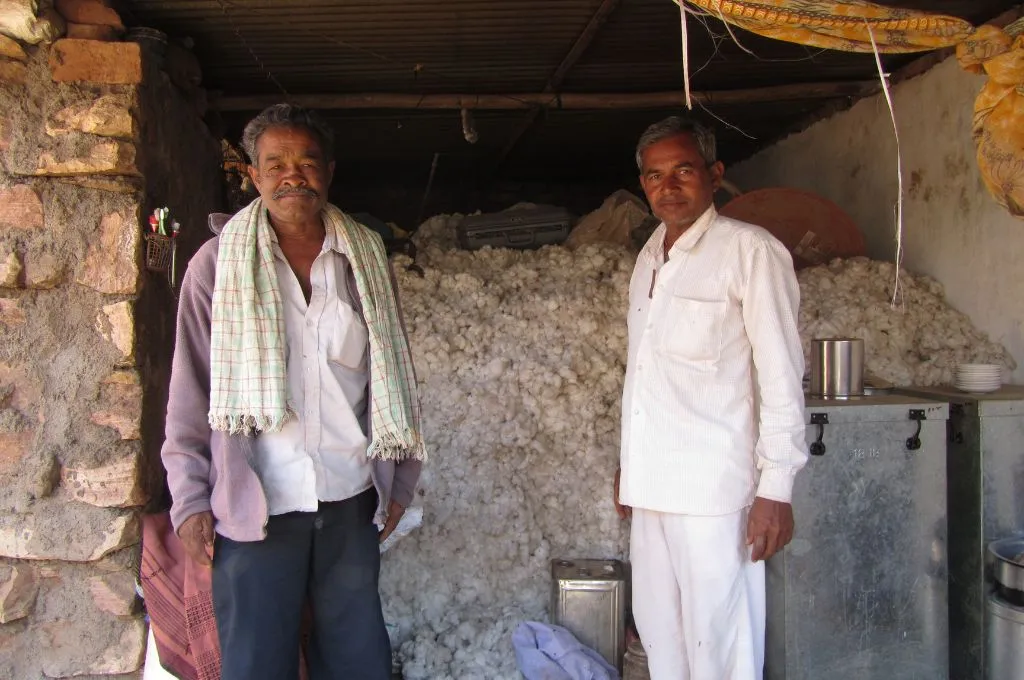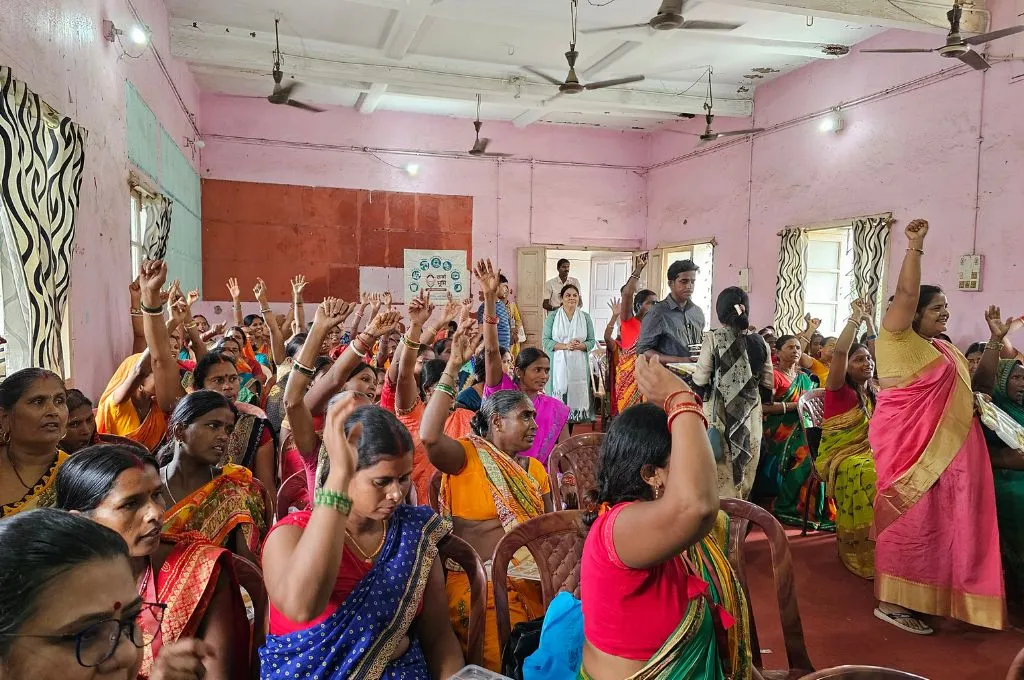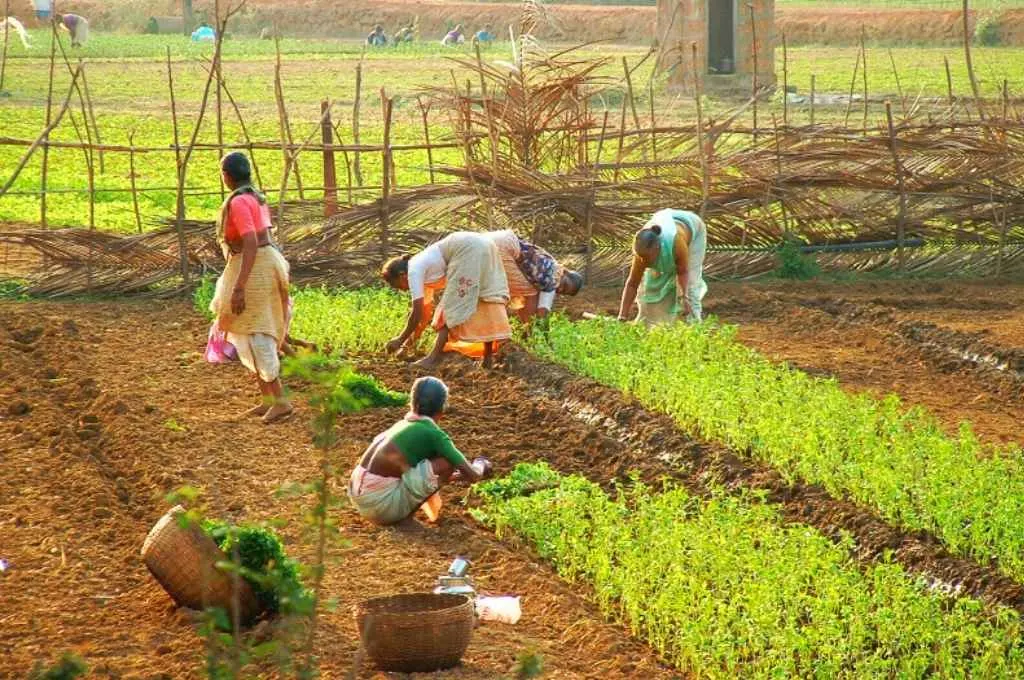My name is Laxmiprya Sahoo, and for the past three years I have been working as a krishi mitra (farmer’s friend) in Rankadeuli village, Nayagarh district, Odisha. My main role involves working with farmers to promote organic farming in the region. I was trained in sustainable agriculture by the Odisha Livelihoods Mission (OLM), organised in collaboration with the Foundation for Ecological Security (FES). I primarily received training in four areas—seed improvement (germination, selection, and treatment), soil health, disease management, and harvesting and storage of seeds.
Before working as a krishi mitra, I was a homemaker. I noticed that we were using a lot of inorganic fertilisers to grow our food, which increased yield but also led to a lot of diseases such as diabetes and blood pressure—even among very young people in my village. When my child grows up, I don’t want them to be susceptible to so many illnesses and diseases—which will happen if we continue using chemicals in farming. I wanted to secure my child’s future, and this is what motivated me to apply for the position of krishi mitra. As a krishi mitra, I want to bring back some of the organic farming practices that our ancestors followed, which will not only feed us but also keep us healthy.
Although my cluster has 60 farmers, I actually work with about 150 farmers across Ranpur block. Most of my work is with small and marginal farmers and widows. OLM works with several self-help groups (SHGs), and through them I reach out to families who might have any nutrition-related issues or to low-income families. I give the women seeds and offer training on creating nutrition gardens, where they grow different vegetables for their own consumption. Why should we buy poisonous vegetables from outside when we can grow on our own?
Being a woman, the male farmers often refused to listen to me when I first started working. They said that they would continue using inorganic fertilisers since it produces large crop yields, which helps them feed their families. I tried explaining how these also lead to a lot of diseases and suggested that they try my approach on a small portion of their land—but they refused.

Given their reluctance, I changed my strategy and approached women in local SHGs instead. Every day I went to a different SHG meeting and built awareness about how inorganic farming leads to more diseases and a higher cost of production. I showed them how using locally available organic products such as cow dung and neem leaves can not only reduce the cost of production but also prevent diseases. Gradually, women started adopting an organic approach in their individual nutrition gardens. When they saw for themselves that this approach produced a good quality yield, they encouraged their husbands to try it on a small area of land.
Over time I have been able to gain the trust of the community. Initially, people would use only 0.5–1 acre of their land for organic farming, but today more than 50 acres of land in my panchayat are farmed organically.
9.00 AM: I finish my household chores and leave for my first field visit of the day. I typically visit four to five farmers from my cluster each day. We discuss any problems the farmers might be facing, be it a disease, an insect, or a pest. Based on my training, we work together to find a solution. In case I’m unsure of what should be done, I take a photo and raise the issue in the weekly guided mentoring sessions organised by FES. Here, a livelihood support professional answers any questions I might have. If they are also unable to solve the issue, the block agricultural officer, who is also present at these meetings, helps us in finding a solution using organic methods. On my next visit to the farmer, I share the solution with them. I act as a bridge between the farmers and the officials.
Today I visit a farmer whose crops were being damaged by an aphid infestation. To combat this, I had suggested a few local ingredients—like neem and cow urine extract—that he could use to create a spray. During my visit, I notice that the problem has been managed to a large extent after using this spray.
I am also trained in soil testing. From time to time, I take soil kits on my field visits to show farmers the harmful effects of using inorganic fertilisers on their soil. I test their soil, and in cases where the soil is too acidic, I tell them that they cannot do grain farming on such soil. Our first task then becomes addressing the bad soil quality by switching to green manure or other organic products.
11.30 AM: I work with farmers to train them in organic farming approaches and help them create their own inputs. Whenever there is a new intervention, method, or technique I want to demonstrate, I bring farmers to my demo plot—a small patch of my own land that I have cultivated using organic farming. Before I start, I ask them to look at my crops and try to find the pests or diseases that they find on their crops. When they are unable to do so, I use the opportunity to talk to them about organic farming practices that can reduce diseases and improve crop quality.
One of the things I worry about is how to make the process more sustainable.
I also use my own plot to try out any new intervention and show farmers the results. Earlier no one would believe me when I spoke about the benefits of organic farming methods. It was only when farmers saw the impact with their own eyes that they started to trust me and became more open to trying out new things. This year we’re trying to promote line sowing and transplanting for the farmers’ main crop—paddy. And so on my own demo field I’ve started line transplanting from east to west, ensuring proper sunlight, soil aeration, and timely application of organic formulations. Farmers don’t want to take a risk with their main source of income, but once they see the benefits, I’m hoping they’ll start to try it on their own land.
Though it’s good to see more farmers shift to organic farming, one of the things I worry about is how to make the process more sustainable. Currently, farmers depend on us for the supply of materials such as vermicompost and other organic inputs. But how are farmers going to sustain this in the long run when I’m not there? And so I’ve started teaching them how to make their own vermicompost, jeevamrut (an organic liquid manure), beejamrut (for seed treatment), and other organic inputs at home. The COVID-19 lockdown was difficult in many ways, but it was also a huge step forward in this direction. During this time, it was difficult for farmers to access inorganic fertilisers from the market, and so I took the opportunity to teach them how to make many things such as handi khata (pot manure) and amrit pani (a fertiliser and seed germinator) on their own.

2.00 PM: Every week the 21 krishi mitras in our block have an hour-long refresher training session where they revise what they have previously learnt and clarify any doubts. Whatever we learn, we then go teach the farmers. Before COVID-19, our training and mentoring sessions would take place in person. However, post the lockdown, it’s all online. We have been using Zoom on our smartphones to attend training sessions, and I have to scan a QR code to ensure that my attendance is recorded. All materials and PDFs—about the methods, ingredients required, how to make organic fertiliser—are delivered to us in Odia through the PDA Participant app. We can download these at any time to refer to and even share them on WhatsApp with farmers.
4.00 PM: I go to the panchayat office to update my diary, where I write about the work I do. Typically, my work involves a wide range of activities—field visits, training, building awareness about nutrition gardens, among other things. Therefore, in the diary I document the specific work I did today, which includes how many farmers I visited, who all attended my training sessions, how many of the farmers agreed or disagreed with me, who disagreed, and why.
I explained how buying INR 5 worth of inorganic fertilisers means they’re also buying INR 50 worth of diseases.
In my training session today, some of the male farmers said that preparing their own organic products is more labour-intensive; with inorganic fertilisers they can simply buy a ready product from the market, even if it is more expensive. I listened to them and tried to understand their concerns. I explained how buying INR 5 worth of inorganic fertilisers means they’re also buying INR 50 worth of diseases. Instead, if they invest a few extra rupees on labour now, they’ll save INR 50 on healthcare expenses in the future. I also show them how their crop yield using inorganic farming might be higher, but their net profit is lower since chemical inputs are expensive to procure. If they use organic farming methods, their yield might be slightly lower but their total investment will be significantly lower as well. I encourage them to try organic farming methods on 1 acre of land and see the difference in cost of production for themselves.
5.00 PM: I come back home from work. I quickly finish my regular household chores and sit down to stitch for some time. I learnt how to stitch when I was very young, and used to make dresses to support my family. I enjoy it and so I’ve continued doing it alongside my work as a krishi mitra. My family has been very supportive of my job as a krishi mitra. When I first started working, no one listened to me. But slowly and patiently I’ve been able to gain people’s trust and respect. The fact that people benefit from organic farming makes me happy and keeps me motivated to encourage more and more farmers to adopt organic farming.
As told to IDR.
—





